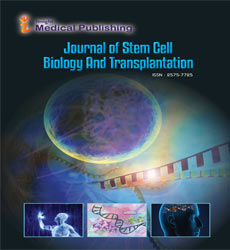ISSN : 2575-7725
Journal of Stem Cell Biology and Transplantation
Cystic fibrosis transmembrane conductance regulator gene amplifiers study in children and adolescents with different Cystic Fibrosis genotypes: the next-generation gene therapy
Abstract
Cystic fibrosis (CF) is an inherited autosomal recessive disorder caused by genetic mutations in CFTR protein. The FDA approved various CF gene modulators, the most recent was the next- generation gene therapy in 2019. This paper aimed at the efficacy of the first triple gene therapy in children and adolescents suffering from cystic fibrosis. A systematic review and metanalysis was conducted following PRISMA guidelines through PubMed/Medline, Clinical trials.gov, Google Scholar, Scopus, Embase, and Europe PMC using the keywords: “Ivacaftor,” “Elexacaftor,” “Tezacaftor,” VX_661”, VX_770”, “VX_445”, “cystic fibrosis” and “gene therapy.” A total of ten randomized clinical trials were included for analysis. Significant absolute change was demonstrated from baseline through 4 weeks favors toward the triple CF gene potentiators in predictive FEV1 [MD=11.80,95%CI=8.47_15.12, p value=<0.00001]; as well as CF_QR score [MD=16.90,95%CI=12.73_21.06, p value=<0.00001] , and BMI kg/m² change [MD=1.04,95%CI=0.84_1.24, p value=<0.00001]. On the same hand, non-significant change was noticed for chloride ion channels activity in treatment group when compared to placebo or VX_770/VX_661 [MD= -12.57,95%CI=-94.46_69.32, p value=0.76]. For Ivacaftor therapy, only a significant reduction in sweat chloride test value toward the treatment group was observed by Ramsey et al., Davies et al., and Moss et al. through 24 weeks [MD=-35.89,95%CI=-59.31_-12.47, p value=0.003]. Tez/Iva group showed no difference between treatment and placebo in term of p FEV1 [MD=1.72,95%CI=-0.95_4.39, p value=0.21]; sweat chloride test [MD=-4.33,95%CI=- 10.43_1.78, p value=0.16]; respiratory domain score [MD=1.82,95%CI=0.92_4.56, p value=0.19]; and a non-notifiable BMI change from baseline [MD=0.03,95%CI=-0.09_0.14, p value=0.66]. In children aged ≥ 6 y old and adolescents with F508del_CFTR mutation, Elexacaftor–Tezacaftor–Ivacaftor tend to be more effective than first-generation therapy, which showed promising results by improving the lung function, body weight, and respiratory-related quality of life.
Open Access Journals
- Aquaculture & Veterinary Science
- Chemistry & Chemical Sciences
- Clinical Sciences
- Engineering
- General Science
- Genetics & Molecular Biology
- Health Care & Nursing
- Immunology & Microbiology
- Materials Science
- Mathematics & Physics
- Medical Sciences
- Neurology & Psychiatry
- Oncology & Cancer Science
- Pharmaceutical Sciences
